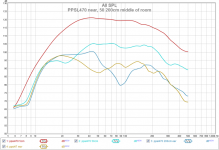It will make the cone appear to have a higher mass in the same way as in a ripole. It does not add loading in the sense that it does not make a stronger connection between cone movement and radiated sound. I would not add three sides as this lowers the parasitic resonance of the air gap. Depending on the desired crossover frequency and the dimensions, this resonance can be a problem.
My experience tells that slot loading (be it ripole, slot, downfire) does not add gain/efficiency at all, when measured as room-response. The effect can be measured only in nearfield few centimeters from the slot - because the air volume displacement must escape from a smaller aperture!
Another and real benefit of downfire bass is that it eliminates the floor bounce nulling, if bass goes high enoug in frequency. Floor bounce freguency nulling depends on height of speaker and listener (mic) and distance. This happens way above subwoofer frequencies.
Subwoofer works with such long wavelengths that boundary gain from the floor comes similarly indpendent of speaker height.
A slot can give better dispersion (less directivity), but this effect works only say above 500Hz - typically for 15" and bigger drivers in two-ways speakers that have xo above 1kHz.
The problem with downfire is that it makes vertical room modes very well!
Anyway, I like downfire low bass and have made two different multiway speakers that way. And a subwoofer with two 15" drivers slot-loaded. The attachment shows the 2x15" PPSL measured nearfield and at various spots in the room.
Another and real benefit of downfire bass is that it eliminates the floor bounce nulling, if bass goes high enoug in frequency. Floor bounce freguency nulling depends on height of speaker and listener (mic) and distance. This happens way above subwoofer frequencies.
Subwoofer works with such long wavelengths that boundary gain from the floor comes similarly indpendent of speaker height.
A slot can give better dispersion (less directivity), but this effect works only say above 500Hz - typically for 15" and bigger drivers in two-ways speakers that have xo above 1kHz.
The problem with downfire is that it makes vertical room modes very well!
Anyway, I like downfire low bass and have made two different multiway speakers that way. And a subwoofer with two 15" drivers slot-loaded. The attachment shows the 2x15" PPSL measured nearfield and at various spots in the room.
Attachments
Look like gold is an almost perfect place to sit as a near ideal sub house curve. While the opposite for green.
C'mon tell us that gold mic location is standing on your head in the corner?
I get similar results when I move my mic around (I use a mic floor stand - very helpful tool). Makes you wonder why people calculate passive crossovers to two decimal places when the room is the big influence. With passive crossovers there's no feasible adjustment later.
B.
C'mon tell us that gold mic location is standing on your head in the corner?
I get similar results when I move my mic around (I use a mic floor stand - very helpful tool). Makes you wonder why people calculate passive crossovers to two decimal places when the room is the big influence. With passive crossovers there's no feasible adjustment later.
B.
Last edited:
Golden line is "mor" which stands for th emic being in the middle of the room also vertically. The 50Hz dip is vertical mode nulling in this case.
Yes, measurements tell many stories! Nearfield is the standard for subwoofers and reliable per se. But even at 50cm ground plane in a room starts showing room modes and reflections!
Data-bass makes measurements mainly outdoors, ground plane at 2m distance.
dB v2
Yes, measurements tell many stories! Nearfield is the standard for subwoofers and reliable per se. But even at 50cm ground plane in a room starts showing room modes and reflections!
Data-bass makes measurements mainly outdoors, ground plane at 2m distance.
dB v2
Golden line is "mor" which stands for th emic being in the middle of the room also vertically. The 50Hz dip is vertical mode nulling in this case....]
Great. You don't have to stand in the corner.
Gold line MOR really does seem like a great place to put your chair for best bass SQ.
Near-field and anechoic (out of doors) certainly have their place as standard lab (in vitro) techniques. But for the DIYer, it is the "bottom line" (mic at your chair) that is the criterion.
Sims would have more utility if room factors (besides radians) were in HornResp.
B.
More about my PPSL470 sub. It has now a minidsp 2x4HD as xo. I found it impossible to eq room modes in this rather small room. Unfortunately my listening spot /height is very problematic, but the only possible. The slot also leaks (fortunately without whistling), but I haven't got the energy to fix it.
A bench style cabinet subwoofer 2x15 closed
A bench style cabinet subwoofer 2x15 closed
Sims would have more utility if room factors (besides radians) were in HornResp.
Just to clarify - the Hornresp Ang parameter is expressed in steradians (SI unit of solid angle), not radians.
- Status
- This old topic is closed. If you want to reopen this topic, contact a moderator using the "Report Post" button.
- Home
- Loudspeakers
- Subwoofers
- Down Firing Subwoofer Loading
